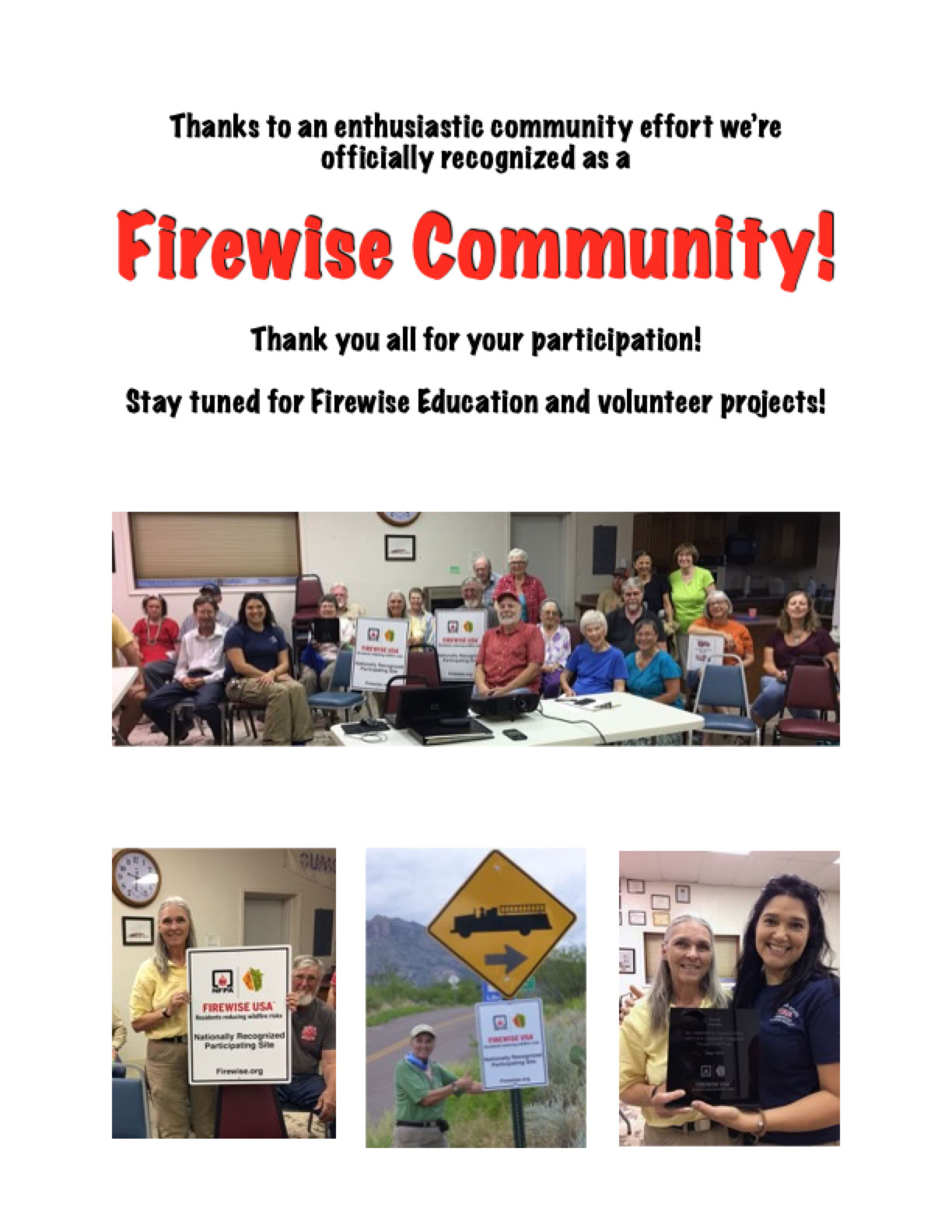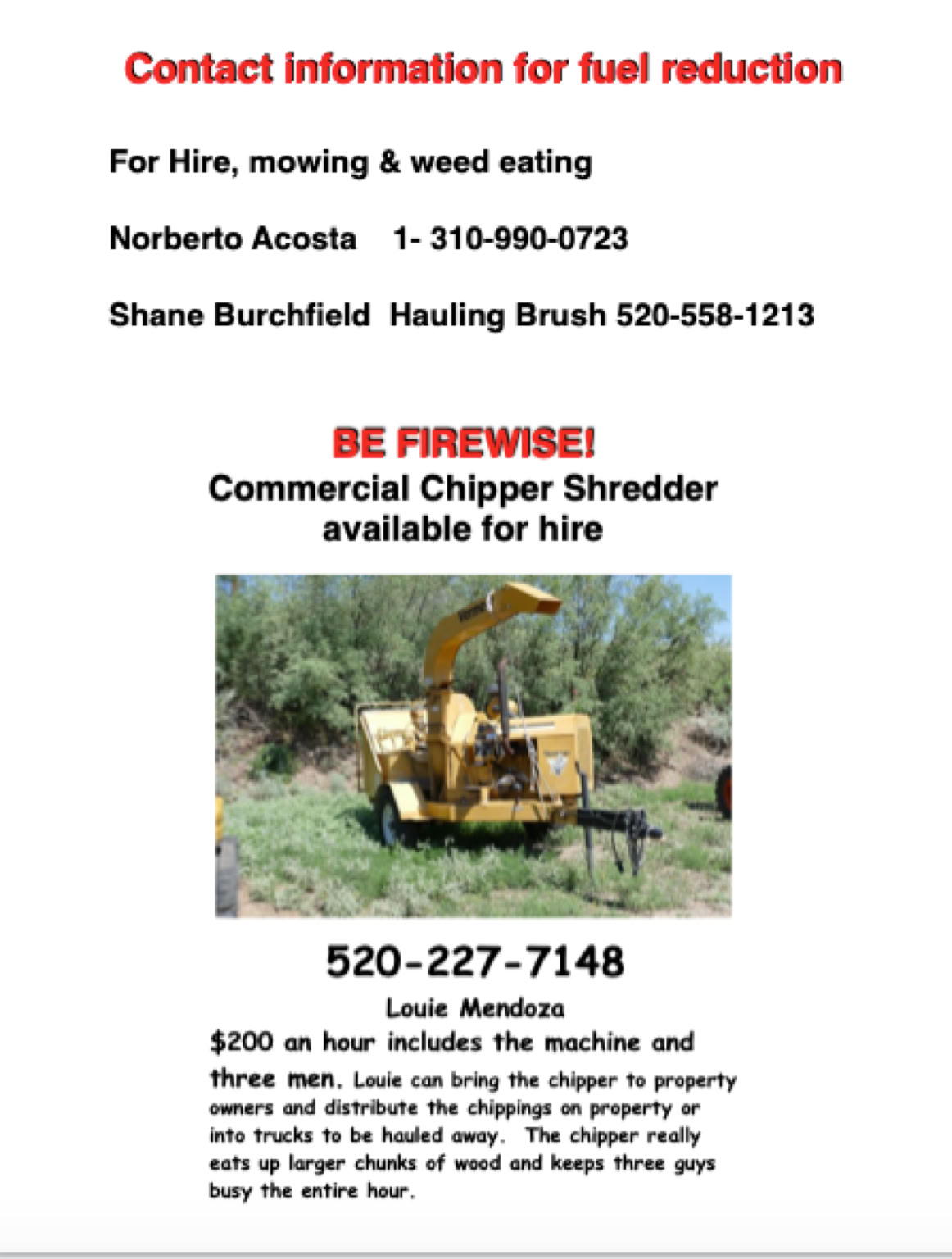Portal, AZ - Rodeo, NM
Serving The Communities Of Portal and Rodeo (www.portal-rodeo.com)
Serving The Communities Of Portal and Rodeo (www.portal-rodeo.com)

Fire Wise

Portal as a Firewise Community
Community members in Portal are proud to have become certified as a nationally recognized Firewise Community (note our sign!), and to have maintained this status for a number of years. After a founding committee developed a plan for Portal to survive wildfires that will inevitably come, residents have worked hard to reduce fuels both on private properties and around shared infrastructure (Post Office, Library and teacherage). More details follow the section on Announcements.
Announcements!!! – educational and volunteer events (community work days)
New Google Group: So far, 103 community members have requested inclusion in a new Google Group where we will post educational events and work opportunities, e.g., clean-up of fuels surrounding local infrastructure. Request inclusion in this group by emailing Dinah Davidson at firewise.portalaz@gmail.com .
Spring winds: You’ve recently seen how hard the winds can blow here. Now imagine how it would feel to have those winds driving fire toward your home! Spring wildfire season is here, and with all the rain we’ve had in the past 12 months, there will be lots of tall, dry grass to carry fire to your mesquite and trees in April – June. Be aware, and be prepared!
What does it mean to be Firewise?
Being Firewise is not an end state but the process of creating and maintaining an environment as safe as possible from wildfire. Structures can be built or hardened to resist ignition by ember storms that are the advancing ‘front’ of wildfire and the primary vulnerability of homes and outbuildings. Gutters should be cleaned of vegetative debris, and firewood stored at least 30’ from structures. Vegetative fuels should be removed near structures and modified in surrounding zones to create conditions favoring low-intensity ground fire as well as discontinuities (fuel breaks) in canopy cover. The latter treatments retard transport of flames into tree canopies via ladder fuels like shrubs and lower tree branches, and they reduce the threat of catastrophic crown fires. Because lax structure hardening and vegetation management on one property pose a threat to neighboring properties, Firewise practices are most effective when adopted by entire neighborhoods, with everyone trying to be good neighbors.
Ember storms, and ‘ready, set, go’!
The majority of homes lost to wildfire succumb to showers of embers entering nooks and crannies, rather than to advancing walls of flames (though the latter can happen). Also called firebrands, embers can penetrate attic vents, lodge in stacks of firewood, and even ignite brooms and door mats left on porches. Some vulnerabilities to embers must be addressed in advance, e.g., by protecting attic ventes with metal screen, cleaning gutters, and keeping woodpiles distant. Others, e.g., moving porch furniture, brooms and other flammables away from structures, are tackled at a ‘ready, set, go’ moment as fire approaches.
Protecting your home from ember-ignition:
https://www.youtube.com/watch?v=vL_syp1ZScM
History of the Firewise program in Portal – 2018 to present
Portal owes a huge debit of gratitude to Debb and Budd Johnson, who founded and organized this community effort after having literally had “a fire lit under them” back in June, 2017. Flames escaping from a structure fire nearby ignited a small wildfire which burned behind the Post Office, Library, and teacherage, and onto their property. The neighbors, young and old, worked valiantly to contain the fire until Portal Rescue Firefighters had been summoned and arrived on scene. A change in wind direction was fortuitous for all.
Motivated by their new-found appreciation of the community’s vulnerability to wildfire, Debb brought in outside expertise from the Arizona Department of Forestry and Fire Management to present a Sew What? forum, and they organized the first assessment class presented by AZDFFM instructors. That class trained a number of local property owners to recognize vulnerabilities in structures and surrounding vegetation. Several of these trainees (Debb and Budd, then-Portal Rescue-President Bill Wilbur, Lee Dyal, Dinah Davidson and Barb Miller), generously made themselves available to visit and assess properties of their neighbors, leaving behind reports to encourage strictly voluntary improvements. Subsequently, homeowners have sought to find a sustainable balance between safety and a desire to maintain environmental harmony in a wildland setting.
Debb also put together a Firewise Committee to set boundaries for the target area, develop realistic goals and schedule educational and work events. On June 9, 2018, she submitted the Firewise Application (written by Dinah Davidson) and, through November of 2022, handled all the required annual paperwork documenting assessments and “community investment” in Firewise preparation. With Jackie Lewis, Debb developed a phone tree to notify residents during emergencies and to stage a practice evacuation drill. Debb also successfully applied for Firewise recertification, secured small grants to fund a trailer for hauling brush removed on National Community Wildfire Protection Day, and distributed Firewise literature at local events (Soup’s On, the FOCCC Spring Garden Party, Heritage Days, and Oktoberfest). Lee Dyal mapped local properties and is currently modernizing that data base so that EMS and Firewise personnel can locate residences accurately.
Clearly, the Firewise program would not exist in Portal without the extraordinary efforts of Debb and Budd Johnson, and we thank them profusely!
What are the current geographic boundaries of Firewise here in Portal?
The Portal Firewise Community presently encompasses Cave Creek Canyon, together with private land holdings up through the American Museum’s Southwest Research Station (SWRS). It also includes neighborhoods immediately surrounding Portal village, down in elevation through H Bar M Rd, and along Foothills Rd. through Sky Village. These boundaries don’t preclude other localities joining at some later date, if at least 70% of residents commit to organizing their own Firewise neighborhoods. In this way, the Portal Firewise Community could eventually include properties within adjacent valley regions (to Stateline Rd.), and extending to Paradise, Whitetail Canyon and Sulphur Canyon.
We need your participation to maintain our Firewise status
Evidence of the Community’s commitment to Firewise practices is a prerequisite for annual recertification. That evidence is tallied yearly in the form of monetary investment in structure hardening and fuels reduction, as well as credit for the property owners’ own work hours. If you are a part of this Community (see above), please keep track of hours worked and expenses, and then report them to Dinah Davidson when she circulates a request early next fall. Data starting in November, and concluding at the time of the request, must be summarized and reported by the end of October.
Reports from Portal Firewise Community members have always exceeded the minimum investment for annual recertification. Let’s keep this success going!
Invitation to make and keep Portal Firewise!
The US Forest Service spent a great deal of money (and assumed more than enough risk!) protecting our beloved Cave Creek Canyon and our local economy from the Horseshoe II fire. It will not have the resources to provide the same degree of protection in the future. The Community must step up and do its part, and the Community is only as strong as its weakest link. Don’t let that be you! The Firewise Committee invites your participation in our local Firewise program, and we can provide several enticements.
• Assessments are free, so please take advantage of one.
• We hope to organize several alternative ways of disposing of downed brush (but sorry, no spiny mesquite)
• Your insurer may offer you reduced rates after documenting your work.
• If we work together toward Community Firewise status, the US Forest Service, BLM, and AZ State lands will pitch in and do their part on government lands adjacent to our private properties.



